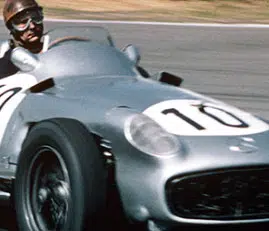2017 F1 World Championship
- 2017
- F1
- F1 World Championship
Having dominated for three years, Mercedes-Benz faced a renewed challenge from Ferrari in 2017. The Ferrari SF70H was initially the faster race car but the Scuderia’s challenge evaporated during the Asian autumn races thanks to costly mechanical failures and the startline accident in Singapore.
Lewis Hamilton responded to the disappointments of 2016 in style to clinch a fourth World Championship with two races to go. The Englishman won nine times and started from the front of the grid on 11 occasions as he surpassed Michael Schumacher’s record for pole positions. New team-mate Valtteri Bottas scored his breakthrough victories in Russia, Austria and Abu Dhabi as he finished third in the standings.
The Ferrari SF70H was initially the faster and more consistent car in race trim and Sebastian Vettel led the championship until the summer break. The Mercedes-Benz F1 W08 was quicker overa single lap but its inconsistency led Toto Wolff to describe it as a “capricious diva.” Vettel and Hamilton went wheel-to-wheel in Spain and clashed in Baku when Vettel intentionally drove into his title rival after wrongly believing he had been “brake tested” behind the safety car. The German then crashed into team-mate Kimi Räikkönen and Red Bull’s Max Verstappen at the start of the Singapore Grand Prix as the title momentum shifted. Vettel then suffered a couple of engine failures in Malaysia and early retirement in Japan as his championship hopes faded.
Red Bull suffered a slow start to its campaign due to a horsepower deficit and engine reliability issues. Strong development of the RB13 saw both Daniel Ricciardo and Max Verstappen win races and finish fifth and sixth overall. Ricciardo won in Azerbaijan when both Hamilton and Vettel were delayed while Verstappen recovered from a run of poor reliability to score in Malaysia and Mexico.
Force India retained fourth in the World Championship but that success was overshadowed by the simmering tension between Sergio Pérez and newcomer Esteban Ocon. The BWT-sponsored pink cars made repeated contact in Azerbaijan, Hungary and twice in Belgium that forced the imposition of team orders. Also Mercedes-powered, Williams recalled Felipe Massa from short-lived retirement to mentor 18-year-old rookie Lance Stroll. The Brazilian veteran outperformed the well financed Stroll but it was the latter who enjoyed the headline achievements – third in Baku and on the front row at Monza.
Renault’s gradual improvement as a works team gathered pace in 2017 with Nico Hülkenberg 10th overall. Jolyon Palmer endured a difficult second season and was replaced by Toro Rosso’s Carlos Sainz with four races to go. Sainz began the season partnering Daniil Kvyat at Toro Rosso and earned that works promotion with several impressive displays that included finishing fourth in Singapore. In contrast, Kvyat grew ever-more frustrated and was released before the end of an error-prone campaign. Pierre Gasly and Le Mans winner Brendon Hartley completed the season for Red Bull’s junior team although engine penalties thwarted meaningful results.
Haas-Ferrari fielded Romain Grosjean and Kevin Magnussen for its second season and finished eighth overall. McLaren-Honda endured a woeful season thanks to the least powerful and least reliable engine. That was enough for McLaren’s new management who eventually negotiated a switch to Renault-power for 2018. At the back of the grid Sauber underwent a mid-season restructure and, given McLaren’s uncertain plans, cancelled its end-of-season switch to Honda engines.
The rules were revised with wider, faster cars and fatter tyres delivering the fastest lap times in more than a decade.





